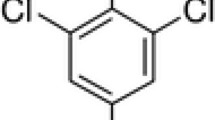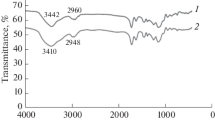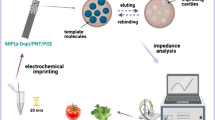Abstract
This research reports the first application of poly(levodopa) in the development of a molecularly imprinted sensor. A novel electrochemical sensor with high selectivity and sensitivity was developed for imidacloprid (IMD) determination based on an imprinted poly(levodopa) electro-polymerized on electrodeposited TiO2 nanoparticles (TiO2NPs) modified glassy carbon electrode (GCE). High affinity of IMD imprinted poly(levodopa) to IMD provided a very selective response of the electrode to IMD and electrodeposited TiO2NPs at the electrode surface resulted in the electrocatalytic reduction of IMD and consequently high sensitivity of the modified electrode. IMD imprinted poly(levodopa) electro-polymerized on TiO2NPs was well characterized by FT-IR, SEM, and EDX techniques. Sensor response to IMD was investigated by using square wave voltammetry (SWV), cyclic voltammetry (CV), and differential pulse voltammetry (DPV) techniques. The sensor showed a really vast linear range of 2–400 μM, completely low detection limit (LoD) of 0.3 μM, and limit of quantitation (LoQ) of 1 μM by SWV measurements that are very acceptable in comparison to other reported IMD sensors. Sensor application in real samples for IMD determination showed good applicability of the developed sensor. Response time is very short and the sensor showed suitable repeatability and stability after use several times.

ᅟ












Similar content being viewed by others
References
Majidi MR, Baj RFB, Bamorowat M. Ionic liquid modified carbon-ceramic electrode with structure similar to graphene nanoplatelets: application to imidacloprid determination in some agricultural products. Measurement. 2016;93:29–35.
Kobashi K, Harada T, Adachi Y, Mori M, Ihara M, Hayasaka D. Comparative ecotoxicity of imidacloprid and dinotefuran to aquatic insects in rice mesocosms. Ecotoxicol Environ Saf. 2017;138:122–9.
Xia X, Xia X, Huo W, Dong H, Zhang L, Chang Z. Toxic effects of imidacloprid on adult loach (Misgurnus anguillicaudatus). Environ Toxicol Pharmacol. 2016;45:132–9.
Jeria Y, Bazaes A, Báez ME, Espinoza J, Martínez J, Fuentes E. Photochemically induced fluorescence coupled to second-order multivariate calibration as analytical tool for determining imidacloprid in honeybees. Chemom Intell Lab Syst. 2017;160:1–7.
Zhang Y, Yang Y, Sun H, Liu Z. Metabolic imidacloprid resistance in the brown planthopper, nilaparvata lugens, relies on multiple P450 enzymes. Insect Biochem Mol Biol. 2016;79:50–6.
Lee KL, You ML, Tsai CH, Lin EH, Hsieh SY, Ho MH, et al. Nanoplasmonic biochips for rapid label-free detection of imidacloprid pesticides with a smartphone. Biosens Bioelectron. 2016;75:88–95.
Zheng Q, Niu Y, Li H. Synthesis and characterization of imidacloprid microspheres for controlled drug release study. React Funct Polym. 2016;106:99–104.
Tan X, Hu Q, Wu J, Li X, Li P, Yu H, et al. Electrochemical sensor based on molecularly imprinted polymer reduced graphene oxide and gold nanoparticles modified electrode for detection of carbofuran. Sens Actuators B Chem. 2015;220:216–21.
Kumaravel A, Chandrasekaran M. Electrochemical determination of imidacloprid using nanosilver Nafion®/nanoTiO2 Nafion® composite modified glassy carbon electrode. Sens. Actuators, B Chem. 2011;158:319–26.
Lei W, Han Z, Si W, Hao Q, Zhang Y, Xia M, et al. Sensitive and selective detection of imidacloprid by graphene-oxide-modified glassy carbon electrode. Chem Aust. 2014;1:1063–7.
Lei W, Wu Q, Si W, Gu Z, Zhang Y, Deng J, et al. Electrochemical determination of imidacloprid using poly (carbazole)/chemically reduced graphene oxide modified glassy carbon electrode. Sens. Actuators, B Chem. 2013;183:102–9.
Si W, Han Z, Lei W, Wu Q, Zhang Y, Xia M, et al. Fast electrochemical determination of imidacloprid at an activated glassy carbon electrode. J Electrochem Soc. 2014;161:B9–B13.
Brahim MB, Ammar HB, Abdelhédi R, Samet Y. Electrochemical behavior and analytical detection of imidacloprid insecticide on a BDD electrode using square-wave voltammetric method. Chin Chem Lett. 2016;27:666–72.
Kumaravel A, Chandrasekaran M. Electrochemical determination of chlorpyrifos on a nano-TiO2/cellulose acetate composite modified glassy carbon electrode. J Agric Food Chem. 2015;63:6150–6.
Jiang H, Jiang D, Shao J, Sun X. Magnetic molecularly imprinted polymer nanoparticles based electrochemical sensor for the measurement of gram-negative bacterial quorum signaling molecules (N-acyl-homoserine-lactones). Biosens Bioelectron. 2016;75:411–9.
Shoji R, Takeuchi T, Kubo I. Atrazine sensor based on molecularly imprinted polymer-modified gold electrode. Anal Chem. 2003;75:4882–6.
Lian W, Liu S, Yu J, Xing X, Li J, Cui M, et al. Electrochemical sensor based on gold nanoparticles fabricated molecularly imprinted polymer film at chitosan–platinum nanoparticles/graphene–gold nanoparticles double nanocomposites modified electrode for detection of erythromycin. Biosens Bioelectron. 2012;38:163–9.
Do MH, Florea A, Farre C, Bonhomme A, Bessueille F, Vocanson F, et al. Molecularly imprinted polymer-based electrochemical sensor for the sensitive detection of glyphosate herbicide. Int J Environ Anal Chem. 2015;95:1489–501.
Introna B, Mazzotta E, Turco A, Malitesta C, Mohammadi R, Ramezany F, et al. Electrochemical detection of serotonin using polyethylenedioxythiophene and core-shell molecularly imprinted polymer nanoparticles. SENSORS, 2014 IEEE, IEEE2014, pp. 309–312.
Zaidi SA, Shin JH. Molecularly imprinted polymer electrochemical sensors based on synergistic effect of composites synthesized from graphene and other nanosystems. Int J Electrochem Sci. 2014;9:4598–616.
Rezaei B, Foroughi-Dehnavi S, Ensafi AA. Fabrication of electrochemical sensor based on molecularly imprinted polymer and nanoparticles for determination trace amounts of morphine. Ionics. 2015;21:2969–80.
Zhang Z, Li J, Fu L, Liu D, Chen L. Magnetic molecularly imprinted microsensor for selective recognition and transport of fluorescent phycocyanin in seawater. J Mater Chem A. 2015;3:7437–44.
Wang X, Yu S, Liu W, Fu L, Wang Y, Li J, et al. Molecular imprinting based hybrid ratiometric fluorescence sensor for the visual determination of bovine hemoglobin. ACS Sensors. 2018;3:378–85.
Yang Q, Li J, Wang X, Peng H, Xiong H, Chen L. Strategies of molecular imprinting-based fluorescence sensors for chemical and biological analysis. Biosens Bioelectron. 2018;112:54–71.
Chen L, Wang X, Lu W, Wu X, Li J. Molecular imprinting: perspectives and applications. Chem Soc Rev. 2016;45:2137–211.
Jiang LC, Zhang WD. Electrodeposition of TiO2 nanoparticles on multiwalled carbon nanotube arrays for hydrogen peroxide sensing. Electroanalysis. 2009;21:988–93.
Vetrivel V, Rajendran K, Kalaiselvi V. Synthesis and characterization of pure titanium dioxide nanoparticles by sol-gel method. Int J Chem Tech Res. 2015;7:1090–7.
Wang Z, Jiang T, Du Y, Chen K, Yin H. Synthesis of mesoporous titania and the photocatalytic activity for decomposition of methyl orange. Mater Lett. 2006;60:2493–6.
Gao Z, Pang L, Feng H, Wang S, Wang Q, Wang M, et al. Preparation and characterization of a novel imidacloprid microcapsule via coating of polydopamine and polyurea. RSC Adv. 2017;7:15762–8.
Quintás G, Armenta S, Garrigues S, Guardia MDL. Fourier transform infrared determination of imidacloprid in pesticide formulations. J Braz Chem Soc. 2004;15:307–12.
Tan JM, Foo JB, Fakurazi S, Hussein MZ. Release behaviour and toxicity evaluation of levodopa from carboxylated single-walled carbon nanotubes. Beilstein J Nanotechnol. 2015;6:243–53.
Kura AU, Al Ali SH, Hussein MZ, Fakurazi S, Arulselvan P. Development of a controlled-release anti-parkinsonian nanodelivery system using levodopa as the active agent. Int J Nanomedicine. 2013;8:1103–10.
Behnajady M, Eskandarloo H, Modirshahla N, Shokri M. Investigation of the effect of sol–gel synthesis variables on structural and photocatalytic properties of TiO2 nanoparticles. Desalination. 2011;278:10–7.
Papp Z, Švancara I, Guzsvány V, Vytřas K, Gaál F. Voltammetric determination of imidacloprid insecticide in selected samples using a carbon paste electrode. Microchim Acta. 2009;166:169–75.
Navalón A, El-Khattabi R, González-Casado A, Vilchez JL. Differential-pulse polarographic determination of the insecticide imidacloprid in commercial formulations. Microchim Acta. 1999;130:261–5.
Guzsvány V, Kádár M, Papp Z, Bjelica L, Gaál F, Toth K. Monitoring of photocatalytic degradation of selected neonicotinoid insecticides by cathodic voltammetry with a bismuth film electrode. Electroanalysis. 2008;20:291–300.
Guzsvány VJ, Gaál FF, Bjelica LJ, Ökrész SN. Voltammetric determination of imidacloprid and thiamethoxam. J Serb Chem Soc. 2005;70:735–43.
Funding
This work was supported by the Iran National Science Foundation [Grant No. 95004691].
Author information
Authors and Affiliations
Corresponding author
Ethics declarations
Conflict of interest
The authors declare that they have no competing interests.
Rights and permissions
About this article
Cite this article
Ghodsi, J., Rafati, A.A. A novel molecularly imprinted sensor for imidacloprid pesticide based on poly(levodopa) electro-polymerized/TiO2 nanoparticles composite. Anal Bioanal Chem 410, 7621–7633 (2018). https://doi.org/10.1007/s00216-018-1372-4
Received:
Revised:
Accepted:
Published:
Issue Date:
DOI: https://doi.org/10.1007/s00216-018-1372-4




